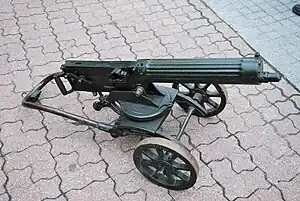Maxim gun
The Maxim gun is a recoil-operated machine gun invented in 1884 by Hiram Stevens Maxim. It was the first fully automatic machine gun in the world.[14]
The Maxim gun has been called "the weapon most associated with imperial conquest" by historian Martin Gilbert,[15] and was heavily used by colonial powers during the "Scramble for Africa". Afterwards, Maxim guns also saw extensive usage by different armies during the Russo-Japanese War, the First and Second World Wars, as well as in contemporary conflicts.
The Maxim gun was greatly influential in the development of machine guns, and it has multiple variants and derivatives.
Design

The Maxim gun featured one of the earliest recoil-operated firing systems in history. Energy from recoil acting on the breech block is used to eject each spent cartridge and insert the next one. Maxim's earliest designs used a 360-degree rotating cam to reverse the movement of the block, but this was later simplified to a toggle lock. This made it vastly more efficient and less labor-intensive than previous rapid-firing guns, such as the manually cranked Mitrailleuse, Gatling, Gardner, or Nordenfelt.
The Maxim gun was water cooled, allowing it to sustain its rate of fire far longer than air-cooled guns. The extra weight and complexity this added, however, made it heavier and less flexible in use.
Trials demonstrated that the Maxim could fire 600 rounds per minute.[16] Compared to modern machine guns, the Maxim was heavy, bulky, and awkward. A lone soldier could fire the weapon, but it was usually operated by a team of men, usually 4 to 6. Apart from the gunner, other crew were needed to speed reload, spot targets, and carry and ready ammunition and water. Several men were needed to move or mount the heavy weapon.
Production company
Maxim established the Maxim Gun Company with financing from Albert Vickers, son of steel entrepreneur Edward Vickers. A blue plaque on the Factory where Maxim invented and produced the gun is to be found in Hatton Garden at the junction with Clerkenwell Road in London.
Albert Vickers became the company's chairman, and it later joined hands with a Swedish competitor, Nordenfelt, to become Maxim Nordenfelt Guns and Ammunition Company. The Post Office Directory of trades in London of 1895 lists its office at 32 Victoria Street SW (London) on page 1579.
Finally, the company was absorbed into the mother Vickers company, leading first to the Maxim-Vickers gun and then, after Vickers' redesign, the Vickers machine gun.
History
Development (1883–1884)
Maxim's first British patents relating to the development of the Maxim gun were granted in June and July 1883.[17][18] The first prototype was demonstrated to invited guests in October 1884.[19]
Use in colonial warfare (1886–1914)
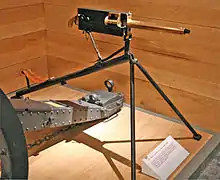

A prototype of the Maxim gun was given by Hiram Maxim to the Emin Pasha Relief Expedition in 1886–1890, under the leadership of Henry Morton Stanley. More a publicity stunt than a serious military contribution, in view of the main financier of the expedition, William Mackinnon, "merely exhibiting" the gun was likely to "prove a great peace-preserver".[20] The weapon was used on several occasions, especially during the expedition's retreat from central Africa, not because of its devastating effects, but as an effective means to scare off attackers. One of the first uses of the Maxim gun by British Forces was in the 1887 Yoni Expedition.[21] The same prototype used by Stanley was brought back to central Africa by Frederick Lugard, where it played an instrumental role in the establishment of the Uganda Protectorate.[22]
The first unit in the world to receive the Maxim was the expeditionary force led by Hermann Wissmann which was sent in 1888 by the German Imperial government to its colonies in East Africa to suppress the Abushiri Revolt.[23] Wissmann was issued one of the first Maxim guns which had reached Germany and used it successfully in his capture of Pangani.[24]
The Singapore Volunteer Corps received a Maxim gun in 1889, but it was never used. This was a civilian volunteer defence unit on the British colony.[25]
The Maxim gun was first used extensively in an African conflict during the First Matabele War in Rhodesia. During the Battle of the Shangani, 700 soldiers fought off 5,000 Matabele warriors with just five Maxim guns. It played an important role in the "Scramble for Africa" in the late 19th century. The extreme lethality was employed to devastating effect against obsolete charging tactics, when African opponents could be lured into pitched battles in open terrain. As it was put by Hilaire Belloc, in the words of the figure "Blood" in his poem "The Modern Traveller":
Whatever happens, we have got
The Maxim gun, and they have not.[26]
However, the destructive power of the Maxim gun in colonial warfare has often been embellished by popular myth. Modern historical accounts suggest that, while it was effective in pitched battles, as in the Matabele wars or the Battle of Omdurman, its significance owed much to its psychological impact.
A larger-calibre version of the Maxim, firing a one-pound shell, was built by Maxim-Nordenfeldt. This was known in the Second Boer War (in South Africa) as the Pom-Pom from its sound. The Boers' "one-pounder" Maxim-Nordenfeldt was a large caliber, belt-fed, water-cooled "auto cannon" that fired explosive rounds (smokeless ammunition) at 450 rounds per minute.[27][28]
The Maxim gun was also used in the Anglo-Aro War (in present-day Nigeria) of 1901–1902.[29]
National and military authorities were reluctant to adopt the weapon, and Maxim's company initially had some trouble convincing European governments of the weapon's efficiency. Soldiers generally held a great mistrust of machine guns due to their tendency to jam. In the 1906 version of his book Small Wars, Charles Callwell says of machine guns: "The older forms are not suitable as a rule... they jammed at Ulundi, they jammed at Dogali, they jammed at Abu Klea and Tofrek, in some cases with unfortunate results."[30] However, the Maxim was far more reliable than its contemporaries.[31] A more immediate problem was that, initially, its position was easily given away by the clouds of smoke that the gun produced (although the same was true of artillery pieces and units of troops that the machine gun was intended to replace or supplement, so this wasn't viewed as a particular drawback by the early users). The advent of smokeless powder (developed by, among others, Hiram's brother Hudson Maxim), helped to change this.
The weapon was adopted by the British Army under the guidance of Sir Garnet Wolseley, who had been appointed Commander-in-Chief of the British Army in 1888. In October that year, he placed an order of 120 rifle-calibre Maxims[32] using the same .577/450 ammunition as the Martini–Henry rifles. Wolseley had previously led military expeditions in Africa (the Ashanti war and the Gordon Relief Expedition in 1884–85) and had a reputation for being a strong subscriber to military innovation and reform, which he demonstrated in Africa. There he used machine guns, explored other unconventional ideas, and founded an Egyptian camel corps.
The gun's design was also purchased and used by several other European countries.
Russo-Japanese War
In 1895, the Imperial Japanese Army purchased a number of Maxims and tested them during the 1895 invasion of Taiwan[33] but later decided to standardize on the Hotchkiss machine gun. The Imperial Russian Army likewise purchased 58 Maxim machine guns in 1899 and contracted with Vickers in 1902 to manufacture the design in Russia, although manufacturing did not start until 1910.[34] During the Russo-Japanese War of 1904–1905, the Russian Army employed the Maxim in combat[35] and placed a rush order for another 450 units from overseas suppliers, which were mostly delivered to front-line troops before the end of the war.[34]
World War I (1914–1918)
By World War I, many armies had moved on to improved machine guns. The British Vickers machine gun was an improved and redesigned Maxim, introduced into the British Army in 1912 and remaining in service until 1968. Production took place at Erith in Kent, and some models were fitted to early biplanes also fabricated there. The German Army's Maschinengewehr 08 and the Russian Pulemyot Maxim were both more or less direct copies of the Maxim.
It also saw use during the Russian Civil War, which followed the Revolution in 1917. A picture of the period depicts a Maxim gun mounted on a tachanka, a horse-drawn carriage, along with the gunner, firing backwards at a pursuing White Army regiment. Anarchists attribute this mobile setup to Nestor Makhno.
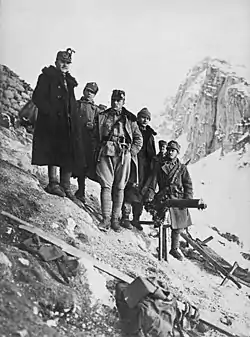 Austro-Hungarian soldiers with a trophy Maxim machine gun in the High Alps, c. 1916
Austro-Hungarian soldiers with a trophy Maxim machine gun in the High Alps, c. 1916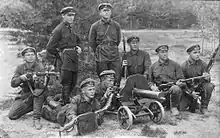 Red Army soldiers with a Maxim machine gun, c. 1930
Red Army soldiers with a Maxim machine gun, c. 1930
American use
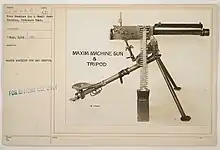

The United States Army had shown interest in the Maxim machine gun since 1887. Model 1889 and Model 1900 Maxims were used for testing, which lasted for years but not continuously. The gun was finally adopted in 1904 as the Maxim Machine Gun, Caliber .30, Model of 1904 as the first rifle-caliber heavy machine gun for standard service in the U.S. Army. The design was characteristic for its visually distinctive cage-like muzzle recoil booster[36] designed by Trevor Dawson and J. Ramsay of Vickers.[37]
The first 50 guns and tripods were made by Vickers, Sons & Maxim in the U.K. chambered for .30-03. Colt's Manufacturing Company was selected to produce it domestically, but challenges with schematics and specifications delayed its introduction. By the time Colt began production in 1908 (which was also the last year orders were placed for the guns), a total of 90 M1904s were made by Vickers. Colt made their machine guns for the new .30-06 caliber, and the ones made by Vickers were re-chambered for the new round. A total of 287 M1904 Maxims were manufactured. The U.S. procured other machine guns after M1904 production ended, including the M1909 Benét–Mercié, the Colt–Vickers M1915, and the Browning M1917.
M1904 Maxims were issued to infantry companies and cavalry. Each company had four guns with associated tripods, ammunition, and 20 mules to transport the heavy guns. The M1904 was deployed in operations in the Philippines, Hawaii, Mexico, and Central and South America, but never saw much combat use. During World War I, it remained in the U.S. for training.[38]
Russo-Ukrainian War
The Maxim, in the form of the PM M1910 chambered in 7.62×54mmR, have been used by both sides of the Russo-Ukrainian War of 2022. Many Maxim guns were retrofitted to suit the nature of modern warfare, including its installation on technicals and the mounting of red dot sights.[39][40][41] At least one documented Maxim gun used by the Ukrainian Ground Forces in the Battle of Bakhmut still had its original iron wheels with no visible modifications. A Ukrainian soldier told BBC News in March 2023: "It only works when there is a massive attack going on...then it really works. So we use it every week".[42]
Variants and derivatives
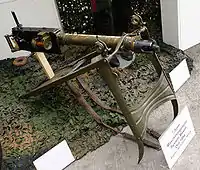
- Maxim five-barrel machine gun, fed from overhead inserted magazines and later belt-fed.
- Vickers machine gun: earlier Maxims had been chambered for earlier British service cartridges, but the Vickers was produced for export available in most of the different calibres and cartridges used by countries around the world, and including a large caliber (.50 inch) as used on Royal Navy warships. The machine gun was 20 pounds (9 kg) lighter and had been tested by the Army in 1909.[43]
- Maschinengewehr 01, made by Deutsche Waffen und Munitionsfabriken (DWM)
- MG 08 derived from MG 01
- Its export version MG 09, featuring the naval tripod mount of the MG 08 instead of the sled
- German indigenous derivatives (e.g., MG 08/15)
- Type 24 heavy machine gun, Chinese variant of MG 09
- Maschinengewehr Modell 1911, Swiss variant of the MG 09 made by Waffenfabrik Bern
- Russian/Soviet Pulemyot Maxima PM1910 and lighter variants Maxim–Tokarev and PV-1 machine gun
- Finnish Maxim M09/21 and Maxim M/32-33
- American M1904
- Romanian-made 6.5 mm version, at least 8–12 were produced and were used by the Romanian Danube Flotilla during World War I[44]
- MG 18 TuF Anti-tank & Anti-aircraft gun
Users
 Argentina
Argentina.svg.png.webp) Belgium
Belgium.svg.png.webp) Bolivia[45]
Bolivia[45] Brazil
Brazil British Empire
British Empire.svg.png.webp) Canada
Canada Chinese Soviet Republic
Chinese Soviet Republic.svg.png.webp) Empire of Japan
Empire of Japan Estonia
Estonia Finland
Finland.svg.png.webp) First Philippine Republic
First Philippine Republic.svg.png.webp) French Third Republic
French Third Republic.svg.png.webp) German Empire
German Empire.svg.png.webp) Kingdom of Albania
Kingdom of Albania_crowned.svg.png.webp) Kingdom of Italy
Kingdom of Italy.svg.png.webp) Kingdom of Montenegro: By 1912 the army had 12 maxims; 50 more were ordered during the Balkan wars but it is not known if they arrived in time[46]
Kingdom of Montenegro: By 1912 the army had 12 maxims; 50 more were ordered during the Balkan wars but it is not known if they arrived in time[46] Kingdom of Romania
Kingdom of Romania.svg.png.webp) Kingdom of Serbia
Kingdom of Serbia.svg.png.webp) Korean Empire
Korean Empire Latvia (1918–1940, .303 and other versions)[47]
Latvia (1918–1940, .303 and other versions)[47] Mexico
Mexico.svg.png.webp) Nazi Germany
Nazi Germany Nicaragua: Used in the Battle of Namasique against the forces of Honduran General Manuel Bonilla[48]
Nicaragua: Used in the Battle of Namasique against the forces of Honduran General Manuel Bonilla[48] New Zealand: Six 577/450 Maxim guns mounted on Field Carriages Mk I were purchased in 1896; they were converted to .303 after 1899. Two of these took part in the Dog Tax War. 29 .303 calliber guns were purchased from Vickers Sons & Maxim in 1901 on Dundonald Galloping Carriages. In 1910 36 guns were ordered on Mk IV tripods with pack saddlery and stores but only arrived in 1913. When the tripods arrived the carriages were scrapped. However initially due to the delay in converting the guns to tripod mounting only one gun was issued to each of the 29 regiments. The New Zealand Mounted Rifles formed a Maxim Gun Battery with British-supplied guns during the Boer War. New Zealand Forces entered WW I with older Maxim machineguns and 36 new ones.[49][50]
New Zealand: Six 577/450 Maxim guns mounted on Field Carriages Mk I were purchased in 1896; they were converted to .303 after 1899. Two of these took part in the Dog Tax War. 29 .303 calliber guns were purchased from Vickers Sons & Maxim in 1901 on Dundonald Galloping Carriages. In 1910 36 guns were ordered on Mk IV tripods with pack saddlery and stores but only arrived in 1913. When the tripods arrived the carriages were scrapped. However initially due to the delay in converting the guns to tripod mounting only one gun was issued to each of the 29 regiments. The New Zealand Mounted Rifles formed a Maxim Gun Battery with British-supplied guns during the Boer War. New Zealand Forces entered WW I with older Maxim machineguns and 36 new ones.[49][50] North Korea
North Korea.svg.png.webp) Ottoman Empire
Ottoman Empire Pahlavi dynasty
Pahlavi dynasty Paraguay
Paraguay Qajar Dynasty: Had a battery of four guns in the 1890s. Also used during the Constitutional Revolution[51]
Qajar Dynasty: Had a battery of four guns in the 1890s. Also used during the Constitutional Revolution[51].svg.png.webp) Qing Dynasty
Qing Dynasty Republic of China
Republic of China Russia
Russia Russian Empire
Russian Empire.svg.png.webp) Second Polish Republic
Second Polish Republic Soviet Union
Soviet Union Spain
Spain Ukraine
Ukraine United States
United States.svg.png.webp) Vichy France
Vichy France
See also
Citations
- "Machine Guns of the Schutztruppe and Overseas Forces". Archived from the original on 20 April 2021.
- "The Soldier's Burden". www.kaiserscross.com. Retrieved 6 May 2023.
- "The King's Royal Rifle Corps Maxim Gun Section". Archived from the original on 2 October 2022.
- Raugh, Harold E.,"The Victorians at War, 1815-1914: An Encyclopedia of British Military History" (2004)
- Davis, Richard Harding (1897). Dr. Jameson's raiders vs. the Johannesburg reformers. New York: R. H. Russell.
- "Second Matabele War".
- Montagu, Hall Wynyard (1939). The Great Drama Of Kumasi. Osmania University, Digital Library Of India. Putnam Limited Press.
- Allen, Charles (2015), "Duel in the Snows" John Murray Press
- "AN OUTLINE HISTORY OF THE PARAGUAYAN ARMY". Archived from the original on 1 December 2022.
- Cotta, Francis Albert "as trincheiras da mantiqueira: os embates da Brigada Sul na Revolução Constitucionalista"
- "Ukrainian Troops Are Still Using This Pre-World War I-Era Maxim Machine Gun In Combat". The Drive. 5 February 2020. Archived from the original on 5 December 2022.
- "Why Ukraine's army still uses a 100-year-old machinegun". The Economist. Archived from the original on 5 December 2022.
- "Bakhmut: Russian casualties mount but tactics evolve". BBC News.
- Encyclopædia Britannica: Sir Hiram Stevens Maxim
- Gilbert, Martin (1997), A History of the Twentieth Century: Volume One: 1900–1933 (1st US ed.), New York: William Morrow and Company, p. 11, ISBN 978-0-688-10064-3
- Stevenson, David (2004). 1914–1918: The History of the First World War. Penguin Books. p. 8. ISBN 978-0-14-026817-1.
- McCallum, p. 46.
- US patent 317161, Hiram Stevens Maxim, "Machine-gun", issued 1885-05-05, assigned to Albert Vickers and Robert R. Symon
- McCallum, p. 49.
- Iain R. Smith: The Emin Pasha Relief Expedition, p. 86.
- "The Yoni Campaign". www.kaiserscross.com. Retrieved 16 September 2022.
- Blaabjerg, Morten (2007), Uhyret der sagde puh! puh! Maxim maskingeværets logistik i det mørkeste Afrika, fra Gordons fald til slaget ved Omdurman 1885–1898 (in Danish), University of Southern Denmark
- G. Richelmann, Schaffung der Wissmanntruppe; in: Becker, Perbandt, Richelmann, Schmidt, Steuber: Hermann von Wissmann, Deutschlands grösster Afrikaner, Berlin 1907, p. 191, online at archive.org
- Richelmann p. 236
- "Singapore Volunteer Corps | Infopedia". eresources.nlb.gov.sg. Archived from the original on 6 January 2023. Retrieved 11 September 2022.
- "The Modern Traveller". colonialwargaming.co.uk. Archived from the original on 28 August 2008.
- Rob Krott (January 2002). "South Africa's National Museum Of Military History". Small Arms Review.
- Martin Pegler (20 May 2013). The Vickers-Maxim Machine Gun. Osprey Publishing. p. 57. ISBN 9781780963839.
- Encyclopedia of African colonial conflicts. Timothy J. Stapleton. Santa Barbara, Calif. 2017. ISBN 978-1-59884-837-3. OCLC 950611553.
{{cite book}}: CS1 maint: location missing publisher (link) CS1 maint: others (link) - Callwell, p. 440.
- Small Wars. 1906. Callwell, p. 559.
- McCallum, p. 67.
- Heath, Ian (1998). Armies of the nineteenth century. Asia : organisation, warfare, dress, and weapons. St. Peter Port, Guernsey: Foundry Books. ISBN 1-901543-01-3. OCLC 50089869.
- Kowner, Rotem (2006). Historical Dictionary of the Russo-Japanese War. Scarecrow. ISBN 978-0-8108-4927-3., p. 225.
- Gilbert, Martin. p. 93.
- "U.S. Maxim Model 1904". February 2004.
- U.S. Patent 870497A
- U.S. Maxim Model 1904 – SAdefensejournal.com, 15 August 2013.
- "Why Ukraine's army still uses a 100-year-old machinegun". The Economist. ISSN 0013-0613. Archived from the original on 5 December 2022. Retrieved 26 May 2022.
- "В РНБО висміяли "новітню" техніку окупантів: смішний перелік". 24 Канал (in Ukrainian). 26 March 2022. Retrieved 26 May 2022.
- "Bakhmut: Russian casualties mount but tactics evolve". BBC News. 16 March 2023. Retrieved 16 March 2023.
- Quentin Sommerville (16 March 2023). "Bakhmut: Russian casualties mount but tactics evolve". BBC News. Retrieved 16 March 2023.
- Graham, Dominick (December 1982). "The British Expeditionary Force in 1914 and the Machine Gun". Military Affairs. 46 (4): 190–193. doi:10.2307/1987613. JSTOR 1987613.
- Marian Sârbu, Marina românâ în primul război mondial 1914–1918, Editura Academiei Navale Mircea cel Bătrân, 2002, pp. 144 and 150
- De Quesada, A. M. (2011). The Chaco War 1932-35 : South America's greatest modern conflict. Philip S. Jowett, Ramiro Bujeiro. Botley, Oxford. ISBN 978-1-84908-416-1. OCLC 762983384.
{{cite book}}: CS1 maint: location missing publisher (link) - Jowett, Philip (2012). Armies of the Balkan Wars 1912-13 : the priming charge for the Great War. Osprey Publishing. ISBN 978-1-299-58155-5. OCLC 842879929.
- Dambītis, Kārlis (2016). Latvijas armijas artilērija 1919.-1940.g.: Vieta bruņotajos spēkos, struktūra un uzdevumi [Artillery of the Latvian Army (1918–1940): structure, tasks and place in the Armed forces] (PhD thesis). University of Latvia. p. 225.
- Jowett, Phillip, Latin American Wars 1900-1941: Osprey Publishing (2018)
- ".450 Maxim Machine Gun (Martini Henry chamber)" (PDF). Archived from the original (PDF) on 1 January 2023.
- ".303 Maxim Machine Gun (magazine rifle chamber)" (PDF). Archived from the original (PDF) on 1 January 2023.
- Farrokh, Kaveh (2011). Iran at war, 1500-1988. Oxford: Osprey Publishing. ISBN 978-1-84603-491-6. OCLC 651902140.
General sources
- Anon., Vickers, Sons and Maxim Limited: Their Works and Manufactures. (Reprinted from 'Engineering') London (1898). It gives plates showing the mechanism of the Vickers Maxim gun and numerous plates showing the variety of mounts available at the end of the 19th century. It also includes numerous plates of the factories in which they were made.
- Callwell, Colonel C.E. (1990). Small Wars: A Tactical Textbook for Imperial Soldiers. London: Greenhill Books. ISBN 978-1-85367-071-8. This is a reprint of the 1906 version.
- Chivers, C. J. (2010). The Gun. Simon & Schuster. ISBN 978-0-7432-7076-2. (See chapter 3: "Hiram Maxim Changes War")
- Ellis, John (1976). The Social History of the Machine Gun. London: Pimlico.
- Ferguson, Niall (2004). Empire. Penguin Books. ISBN 978-0-14-100754-0.
- Goldsmith, Dolf F. (1989). The Devil's Paintbrush: Sir Hiram Maxim's Gun. Collector Grade Publications, Toronto. ISBN 978-0-88935-056-4.
- Headrick, Daniel R. (1981). Tools of Empire. Technology and European Imperialism in the Nineteenth Century. Oxford: Oxford University Press. ISBN 978-1-86176-096-8.
- McCallum, Iain (1999). Blood Brothers: Hiram and Hudson Maxim—Pioneers of Modern Warfare. London: Chatham Publishing. ISBN 978-1-86176-096-8.
External links
- Handbook of the Maxim Automatic Machine Gun, caliber .30, model of 1904, with pack outfits and accessories. US War Department, July 1916
- The Maxim Machine Gun Systems Blueprints by 1906
- Animation of Maxim's prototype machine gun, 1884
- Animation of Maxim's second prototype machine gun 1885
- Animation of Maxim's transitional machine gun 1885
